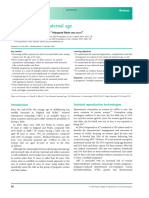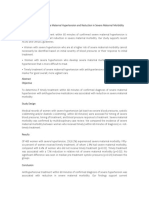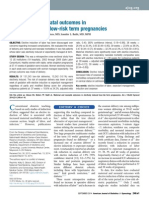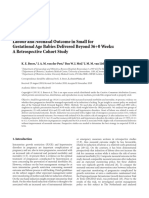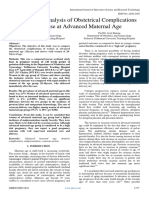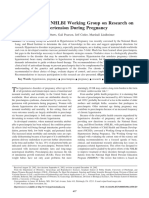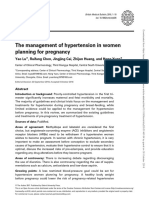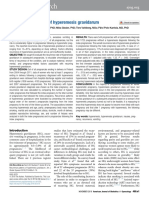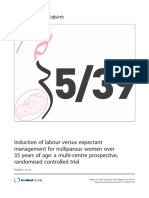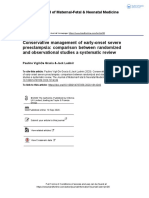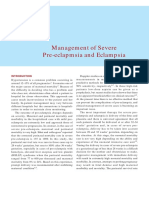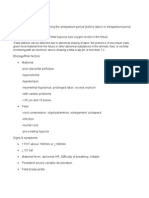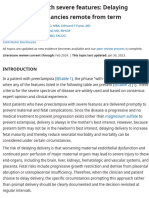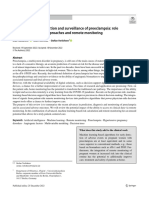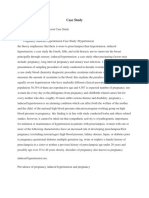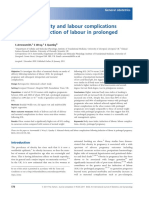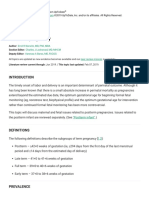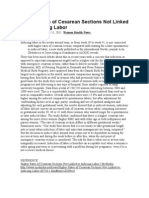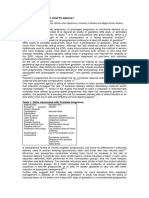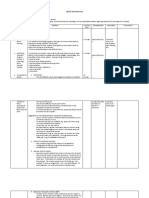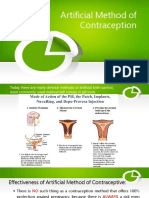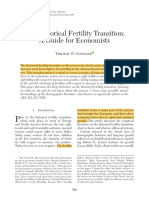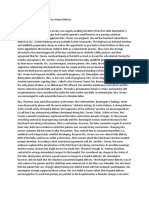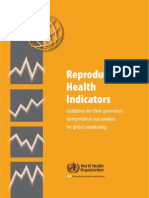0 ratings0% found this document useful (0 votes)
23 viewsTiming of Delivery in Women With Chronic Hypertension: Joanne Bernadette C. Aguilar BSN-2
Timing of Delivery in Women With Chronic Hypertension: Joanne Bernadette C. Aguilar BSN-2
Uploaded by
Joanne Bernadette AguilarThis document discusses the risks and benefits of inducing labor early versus expectant management for women with chronic hypertension during pregnancy. Inducing labor earlier has the potential to decrease risks like preeclampsia and stillbirth but may increase the risk of cesarean delivery. The study found that inducing labor at 38-39 weeks for women with isolated chronic hypertension prevented about 20% of preeclampsia cases without increasing cesarean delivery rates. However, the study had limitations like lacking some potential confounding variable data and being underpowered for assessing rare outcomes. Overall, the findings provide cautious support for inducing labor between 38-39 weeks for women with isolated chronic hypertension to prevent complications, but individual factors must also be considered.
Copyright:
© All Rights Reserved
Available Formats
Download as DOCX, PDF, TXT or read online from Scribd
Timing of Delivery in Women With Chronic Hypertension: Joanne Bernadette C. Aguilar BSN-2
Timing of Delivery in Women With Chronic Hypertension: Joanne Bernadette C. Aguilar BSN-2
Uploaded by
Joanne Bernadette Aguilar0 ratings0% found this document useful (0 votes)
23 views9 pagesThis document discusses the risks and benefits of inducing labor early versus expectant management for women with chronic hypertension during pregnancy. Inducing labor earlier has the potential to decrease risks like preeclampsia and stillbirth but may increase the risk of cesarean delivery. The study found that inducing labor at 38-39 weeks for women with isolated chronic hypertension prevented about 20% of preeclampsia cases without increasing cesarean delivery rates. However, the study had limitations like lacking some potential confounding variable data and being underpowered for assessing rare outcomes. Overall, the findings provide cautious support for inducing labor between 38-39 weeks for women with isolated chronic hypertension to prevent complications, but individual factors must also be considered.
Original Title
hypertension.docx
Copyright
© © All Rights Reserved
Available Formats
DOCX, PDF, TXT or read online from Scribd
Share this document
Did you find this document useful?
Is this content inappropriate?
This document discusses the risks and benefits of inducing labor early versus expectant management for women with chronic hypertension during pregnancy. Inducing labor earlier has the potential to decrease risks like preeclampsia and stillbirth but may increase the risk of cesarean delivery. The study found that inducing labor at 38-39 weeks for women with isolated chronic hypertension prevented about 20% of preeclampsia cases without increasing cesarean delivery rates. However, the study had limitations like lacking some potential confounding variable data and being underpowered for assessing rare outcomes. Overall, the findings provide cautious support for inducing labor between 38-39 weeks for women with isolated chronic hypertension to prevent complications, but individual factors must also be considered.
Copyright:
© All Rights Reserved
Available Formats
Download as DOCX, PDF, TXT or read online from Scribd
Download as docx, pdf, or txt
0 ratings0% found this document useful (0 votes)
23 views9 pagesTiming of Delivery in Women With Chronic Hypertension: Joanne Bernadette C. Aguilar BSN-2
Timing of Delivery in Women With Chronic Hypertension: Joanne Bernadette C. Aguilar BSN-2
Uploaded by
Joanne Bernadette AguilarThis document discusses the risks and benefits of inducing labor early versus expectant management for women with chronic hypertension during pregnancy. Inducing labor earlier has the potential to decrease risks like preeclampsia and stillbirth but may increase the risk of cesarean delivery. The study found that inducing labor at 38-39 weeks for women with isolated chronic hypertension prevented about 20% of preeclampsia cases without increasing cesarean delivery rates. However, the study had limitations like lacking some potential confounding variable data and being underpowered for assessing rare outcomes. Overall, the findings provide cautious support for inducing labor between 38-39 weeks for women with isolated chronic hypertension to prevent complications, but individual factors must also be considered.
Copyright:
© All Rights Reserved
Available Formats
Download as DOCX, PDF, TXT or read online from Scribd
Download as docx, pdf, or txt
You are on page 1of 9
Joanne Bernadette C.
Aguilar BSN-2
Timing of Delivery in Women With Chronic Hypertension
Chronic hypertension complicates between 1% and 5% of pregnancies, and this
proportion is expected to rise given the increasing prevalence of obesity and the increase
in maternal age. Women with chronic hypertension are at increased risk of adverse
pregnancy outcomes including superimposed preeclampsia, fetal growth restriction,
placental abruption, and preterm birth, which result in increased maternal and perinatal
morbidity and mortality.
One of the major controversies regarding the management of pregnancies complicated
by chronic hypertension relates to the optimal timing of delivery. A policy of a routine
induction of labor before 40 weeks of gestation has the potential to decrease the risk of
superimposed preeclampsia, placental abruption, and stillbirth. The main concern with
such a policy has traditionally been an increased risk of cesarean delivery secondary to
failed induction of labor. However, data from low-risk pregnancies suggest that such a
policy may not increase and may even decrease the risk of cesarean delivery. Another
potential concern is that planned early delivery might increase the risk of perinatal
morbidity when performed before 39 weeks of gestation. Finally, a policy of routine
induction of labor has implications with respect to costs and resource use.
Unfortunately, data regarding the benefits and risks of routine induction of labor in women
with chronic hypertension are scarce. Furthermore, interpretation of available studies is
limited by the lack of an adequate control group; lack of adjustment for potential
confounding variables such as maternal body mass index (BMI, calculated as weight
(kg)/[height (m)]2) or parity; the inclusion of women with comorbidities or women who
underwent induction of labor before 37 weeks of gestation and were thus likely to have
been induced for reasons other than chronic hypertension; and by small sample size. As
a result, the optimal timing of delivery in women with chronic hypertension is currently
unclear.Therefore, our aim was to test the hypothesis that routine induction of labor at 38
or 39 weeks of gestation in women with chronic hypertension may decrease the risk of
superimposed preeclampsia and the associated maternal and perinatal complications
without increasing the rate of cesarean delivery.
The main finding of the current study is that, in women with isolated chronic hypertension,
induction of labor at 38 or 39 weeks of gestation may avoid the approximate 20% risk of
superimposed preeclampsia associated with expectant management during the
corresponding weeks without associated increases in the risk of cesarean delivery.
Approximately 25% of women with chronic hypertension will develop superimposed
preeclampsia,11 often late in pregnancy.27 In addition, women with chronic hypertension
are at increased risk of other complications such as placental abruption 8 and
stillbirth.20 Thus, the rationale for routine induction of labor in women with chronic
hypertension is clear, because such a policy would prevent these complications in women
destined to develop these complications later in gestation. However, data on the benefits
and risks of routine induction of labor in women with chronic hypertension are scarce19–
21
and are limited by small sample size, lack of an adequate control group, and by lack of
information on potential confounding variables. The results of our study, in which we tried
to overcome these limitations, provide support for the hypothesis that a policy of routine
induction of labor at 38 or 39 weeks of gestation in women with chronic hypertension can
prevent the complications described.
Our finding that induction is not associated with an increased the risk of cesarean delivery
compared with expectant management is consistent with observational studies of low-
risk women undergoing elective induction of labor.12,13,28 This finding may be attributed to
an increased risk of urgent cesarean delivery in the expectant management groups as a
result of superimposed preeclampsia and to the fact that more than half of the women in
the expectant management groups undergo induction of labor at a more advanced
gestational age.
The fact that we did not find differences in maternal morbidity and neonatal morbidity
(other than respiratory morbidity at 39 weeks of gestation) between the induction of labor
and expectant management groups may be the result of the insufficient sample size.
However, based on the association of superimposed preeclampsia with maternal and
neonatal morbidity,2,29,30 we believe that the approximate 20% risk of superimposed
preeclampsia in the expectant management groups can be used as a surrogate of
adverse maternal and neonatal outcome. We were able to identify only one randomized
controlled study21 and two retrospective studies19,20that compared induction of labor with
expectant management in women with chronic hypertension. Hamed et al randomized 76
women with mild to moderate chronic hypertension to induction of labor at 37 weeks of
gestation compared with expectant management until 41 week of gestation. In contrast
to our findings, they reported that induction of labor at 37 weeks of gestation was
associated with an increased risk of cesarean delivery and admission to the NICU,
whereas it did not affect the risk of developing superimposed preeclampsia. 21 However,
the interpretation of this study is limited by the small sample size (38 women in each arm)
and by the relative early gestational age in the induction of labor group (37 weeks). In a
retrospective population-based study, Hutcheon et al20 found that induction of labor at 38
or 39 weeks of gestation in women with chronic hypertension provided the optimal
balance between the competing risks of stillbirth and neonatal mortality and morbidity.
The main limitation of that study is that the authors were unable to distinguish between
women with uncomplicated chronic hypertension and women with chronic hypertension
who developed superimposed preeclampsia. As a result, some of the women who
underwent induction of labor were induced for superimposed preeclampsia rather than
chronic hypertension. Moreover, the design used by the authors does not provide
comparison of induction of labor with expectant management but merely provides week-
specific estimates of the risk of stillbirth and neonatal mortality and morbidity. In a more
recent small single-center retrospective study, Harper et al19 reported that, in agreement
with our findings, expectant management beyond 39 weeks of gestation in women with
chronic hypertension was associated with increased risk of severe preeclampsia. Beyond
the small number of women in the induction of labor groups (range 20–124), the
interpretation of that study is limited by the fact that they included women with
comorbidities in whom induction of labor was performed for reasons other than chronic
hypertension so that these findings cannot address the role of routine induction of labor
in women with isolated chronic hypertension.
The current study has several limitations. As a result of the population-based design, we
did not have information on several potential confounding variables such as the severity
of chronic hypertension, maternal ethnicity, and differences in the practice of labor
induction and patient populations between individual care providers and medical centers;
thus, residual confounding cannot be ruled out. To simulate a policy of routine (or
preventive) induction of labor in women with isolated chronic hypertension, we excluded
women with the diagnosis of superimposed preeclampsia from the induction of labor
groups, which means that per definition, the rate of superimposed preeclampsia in the
induction of labor group in our study is zero. We recognize that this approach did not allow
us identify women who underwent induction of labor as a result of isolated chronic
hypertension but developed superimposed preeclampsia during the process of induction,
delivery, or in the postpartum period and that this may result in a statistical bias for the
comparison of the rate of superimposed preeclampsia between the induction of labor and
expectant management groups. Finally, despite its relatively large sample size, our study
is insufficiently powered to assess uncommon maternal and perinatal outcomes such as
perinatal mortality, low Apgar scores, and neonatal hypoglycemia.
In summary, we have found that in women with isolated chronic hypertension, induction
of labor at 38 or 39 weeks of gestation may prevent severe hypertensive complications
without associated increases (or with even associated decreases) in the risk of cesarean
delivery and that induction of labor at 39 weeks of gestation is associated with a lower
risk of neonatal respiratory morbidity compared with expectant management. Although
these findings should be interpreted with caution given the limitations described, we
believe that for care providers and women with isolated chronic hypertension who are
considering induction of labor before 40 weeks of gestation, the current study may provide
support for such a practice. The decision regarding the timing of delivery should be further
based on additional factors such as patient preference, the severity of hypertension,
history of preeclampsia in previous pregnancies, presence of fetal growth restriction, and
factors that may affect the risk of cesarean delivery such as parity and Bishop score.
You might also like
- Very Advanced Maternal Age, TOG-2021Document10 pagesVery Advanced Maternal Age, TOG-2021saeed hasan saeedNo ratings yet
- Effects of Early Pregnancy To StudentsDocument30 pagesEffects of Early Pregnancy To Studentsrejenkaye_0871% (7)
- No. 29. Chronic Hypertension in PregnancyDocument9 pagesNo. 29. Chronic Hypertension in Pregnancyrolla_hiraNo ratings yet
- Paguidian, Griffin John D. Bsn4ADocument10 pagesPaguidian, Griffin John D. Bsn4AGj PaguidianNo ratings yet
- 0 Rajiv Gandhi University of Health Sciencesbangalore, Karnatakaproforma For Registration of Subject For DissertationDocument19 pages0 Rajiv Gandhi University of Health Sciencesbangalore, Karnatakaproforma For Registration of Subject For DissertationAndri wijayaNo ratings yet
- Maternal and Neonatal Outcomes in Electively Induced Low-Risk Term PregnanciesDocument16 pagesMaternal and Neonatal Outcomes in Electively Induced Low-Risk Term Pregnanciessri afniNo ratings yet
- Expectant Management of Severe PreeclampsiaDocument14 pagesExpectant Management of Severe PreeclampsiaMDRadfield100% (1)
- Research ArticleDocument6 pagesResearch ArticleayubahriNo ratings yet
- Jurnal MaternitasDocument10 pagesJurnal Maternitasasep saepulohNo ratings yet
- Review Article: Maternal Preeclampsia and Neonatal OutcomesDocument8 pagesReview Article: Maternal Preeclampsia and Neonatal OutcomesMita RestuNo ratings yet
- Journal Pre-Proof: Seminars in PerinatologyDocument17 pagesJournal Pre-Proof: Seminars in Perinatologymarcela quirosNo ratings yet
- Preeclampsia - Antepartum Management and Timing of Delivery - UpToDateDocument16 pagesPreeclampsia - Antepartum Management and Timing of Delivery - UpToDateDương Danh CườngNo ratings yet
- Comparative Analysis of Obstetrical Complications in Nepalese at Advanced Maternal AgeDocument4 pagesComparative Analysis of Obstetrical Complications in Nepalese at Advanced Maternal AgeInternational Journal of Innovative Science and Research TechnologyNo ratings yet
- Lee Et Al-2016-BJOG An International Journal of Obstetrics & GynaecologyDocument8 pagesLee Et Al-2016-BJOG An International Journal of Obstetrics & GynaecologyDhia UlfajriNo ratings yet
- Konstantopoulos 2020Document14 pagesKonstantopoulos 2020Corey WoodsNo ratings yet
- Rajiv Gandhi University of Health Sciences Bangalore, KarnatakaDocument18 pagesRajiv Gandhi University of Health Sciences Bangalore, Karnatakaمالك مناصرةNo ratings yet
- Summary of The NHLBI Working Group On Research On Hypertension During PregnancyDocument9 pagesSummary of The NHLBI Working Group On Research On Hypertension During PregnancycarlosarmijoNo ratings yet
- Spontaneous AbortionDocument17 pagesSpontaneous Abortionanon_985338331No ratings yet
- 1 PB PDFDocument7 pages1 PB PDFAmanda Mustika AdiNo ratings yet
- Conservative Management of Early-Onset Severe Preeclampsia: Comparison Between Randomized and Observational Studies A Systematic ReviewDocument9 pagesConservative Management of Early-Onset Severe Preeclampsia: Comparison Between Randomized and Observational Studies A Systematic ReviewCorey WoodsNo ratings yet
- The Management of Hypertension in Women Planning For PregnancyDocument10 pagesThe Management of Hypertension in Women Planning For PregnancyRadinal PrayitnoNo ratings yet
- Ni Hms 916466Document20 pagesNi Hms 916466cataghyNo ratings yet
- Recurrence Patterns of Hyperemesis Gravidarum: ObstetricsDocument10 pagesRecurrence Patterns of Hyperemesis Gravidarum: Obstetricsnadyanatasya7No ratings yet
- Induction of Labour Versus Expectant Management For Nulliparous Women Over 35 Years of Age: A Multi-Centre Prospective, Randomised Controlled TrialDocument8 pagesInduction of Labour Versus Expectant Management For Nulliparous Women Over 35 Years of Age: A Multi-Centre Prospective, Randomised Controlled TrialAndinNo ratings yet
- Managing Post Partum HypertensionDocument10 pagesManaging Post Partum HypertensionDendyNo ratings yet
- Preeclampsia - Management and Prognosis - UpToDateDocument22 pagesPreeclampsia - Management and Prognosis - UpToDateNunung firda IstiqomahNo ratings yet
- AJOG-Expectant Management of Severe Preeclampsia Remote From Term-7Document9 pagesAJOG-Expectant Management of Severe Preeclampsia Remote From Term-7AQUACOSTA SASNo ratings yet
- A Proposed Plan For Prenatal Care To Minimize Risks of COVID-19 To Patients and Providers - Focus On Hypertensive Disorders of PregnancyDocument8 pagesA Proposed Plan For Prenatal Care To Minimize Risks of COVID-19 To Patients and Providers - Focus On Hypertensive Disorders of PregnancyWeslley FerreiraNo ratings yet
- Exercise During Pregnancy Protects Against Hypertension and Macrosomia: Randomized Clinical TrialDocument8 pagesExercise During Pregnancy Protects Against Hypertension and Macrosomia: Randomized Clinical TrialDaniela VenegasNo ratings yet
- Laborinduction: Areviewof Currentmethods: Mildred M. RamirezDocument11 pagesLaborinduction: Areviewof Currentmethods: Mildred M. RamirezRolando DiazNo ratings yet
- Best Practices For Managing Postpartum HypertensionDocument10 pagesBest Practices For Managing Postpartum HypertensionYhogerlys LucenaNo ratings yet
- Optimal Obstetric Management For Women With Diabetes - The Benefits and Costs of Fetal SurveillanceDocument9 pagesOptimal Obstetric Management For Women With Diabetes - The Benefits and Costs of Fetal SurveillanceWillians ReyesNo ratings yet
- Sibai PDFDocument2 pagesSibai PDFAdriana PajueloNo ratings yet
- Conservative Management of Early-Onset Severe Preeclampsia: Comparison Between Randomized and Observational Studies A Systematic ReviewDocument13 pagesConservative Management of Early-Onset Severe Preeclampsia: Comparison Between Randomized and Observational Studies A Systematic ReviewCorey WoodsNo ratings yet
- Short Stature Is Associated With An Increased Risk of Caesarean Deliveries in Low Risk PopulationDocument6 pagesShort Stature Is Associated With An Increased Risk of Caesarean Deliveries in Low Risk PopulationManangioma ManNo ratings yet
- V615br MarhattaDocument4 pagesV615br MarhattaMarogi Al AnsorianiNo ratings yet
- MATERNAL DISEASE-PEB-EclampsiaDocument10 pagesMATERNAL DISEASE-PEB-Eclampsiaari naNo ratings yet
- Fetal DistressDocument5 pagesFetal DistressRonnie Portillo Cruz100% (1)
- Bahan Referat Postterm PregnancyDocument48 pagesBahan Referat Postterm PregnancyAlyssa DiandraNo ratings yet
- Diabetes y Embarazo Tipo2 PDFDocument3 pagesDiabetes y Embarazo Tipo2 PDFFRM2012No ratings yet
- Induction of Labor With Oxytocin - UpToDateDocument39 pagesInduction of Labor With Oxytocin - UpToDatechristian escamillaNo ratings yet
- Hypertension in Pregnancy 2015Document5 pagesHypertension in Pregnancy 2015nacxit6No ratings yet
- Frederiksen 2018Document7 pagesFrederiksen 2018WinniaTanelyNo ratings yet
- Impact of Preeclampsia and Gestational Hypertension On Birth Weight by Gestational AgeDocument7 pagesImpact of Preeclampsia and Gestational Hypertension On Birth Weight by Gestational AgegeraldersNo ratings yet
- Preeclampsia With Severe FeaturesDocument22 pagesPreeclampsia With Severe FeaturesAnatholeNo ratings yet
- Preeclamsia 1Document15 pagesPreeclamsia 1Pu DeanNo ratings yet
- P ('t':'3', 'I':'668007329') D '' Var B Location Settimeout (Function ( If (Typeof Window - Iframe 'Undefined') ( B.href B.href ) ), 15000)Document5 pagesP ('t':'3', 'I':'668007329') D '' Var B Location Settimeout (Function ( If (Typeof Window - Iframe 'Undefined') ( B.href B.href ) ), 15000)niko4eyesNo ratings yet
- Case StudyDocument13 pagesCase Studyshakuntla Devi0% (2)
- Bjo0118 0578 PDFDocument11 pagesBjo0118 0578 PDFwe sagara dewiNo ratings yet
- Formula ObstetricaDocument4 pagesFormula ObstetricagrupocelestNo ratings yet
- Rethinking IUGR in Preeclampsia: Dependent or Independent of Maternal Hypertension?Document5 pagesRethinking IUGR in Preeclampsia: Dependent or Independent of Maternal Hypertension?Antonius Joko NugrohoNo ratings yet
- Preeclampsia - Clinical Features and Diagnosis - UpToDateDocument35 pagesPreeclampsia - Clinical Features and Diagnosis - UpToDateElvicito ISs100% (1)
- Postterm Pregnancy - UpToDateDocument17 pagesPostterm Pregnancy - UpToDateJosé Abraham Amaya DuarteNo ratings yet
- Winter, Spring, Summer or Fall Temporal Patterns in Placenta-Mediated Pregnancy Complications-An Exploratory AnalysisDocument8 pagesWinter, Spring, Summer or Fall Temporal Patterns in Placenta-Mediated Pregnancy Complications-An Exploratory AnalysisTushar RameshNo ratings yet
- Current Trends For DutyDocument1 pageCurrent Trends For DutyRizalyn VictaNo ratings yet
- Pre Eclampsia - FinalDocument54 pagesPre Eclampsia - Finalsupernurse02No ratings yet
- Hypertensive Disorders in PregnancyDocument20 pagesHypertensive Disorders in PregnancyAnatholeNo ratings yet
- Postdate: When and How To Induce? F. Facchinetti, V. VaccaroDocument5 pagesPostdate: When and How To Induce? F. Facchinetti, V. VaccaroSyahidatul Kautsar NajibNo ratings yet
- Maternal and Perinatal Outcomes After Elective Labor Induction at 39 Weeks in Uncomplicated Singleton Pregnancies - A Meta-Analysis-sotiriadis2018Document27 pagesMaternal and Perinatal Outcomes After Elective Labor Induction at 39 Weeks in Uncomplicated Singleton Pregnancies - A Meta-Analysis-sotiriadis2018trongnguyen2232000No ratings yet
- Complementary and Alternative Medical Lab Testing Part 10: ObstetricsFrom EverandComplementary and Alternative Medical Lab Testing Part 10: ObstetricsNo ratings yet
- Pharmacology Nursing MnemonicsDocument23 pagesPharmacology Nursing MnemonicsJoanne Bernadette Aguilar100% (1)
- Final Post TestDocument23 pagesFinal Post TestJoanne Bernadette AguilarNo ratings yet
- Complete Head To Toe AssessmentDocument13 pagesComplete Head To Toe AssessmentJoanne Bernadette Aguilar100% (1)
- Summary of Findings, Conclusion and Recommendatiojn: The ProblemDocument10 pagesSummary of Findings, Conclusion and Recommendatiojn: The ProblemJoanne Bernadette AguilarNo ratings yet
- Community Health Nursing NotesDocument4 pagesCommunity Health Nursing NotesJoanne Bernadette AguilarNo ratings yet
- Be Reviewed and Tested? (10pts)Document2 pagesBe Reviewed and Tested? (10pts)Joanne Bernadette AguilarNo ratings yet
- Psychotropic MedicationsDocument37 pagesPsychotropic MedicationsJoanne Bernadette AguilarNo ratings yet
- Name: Glenda S, Casundo Date: Nov. 3, 2020 Course/Yr: BSN Iv Comp - Appraisal Quiz No.3Document4 pagesName: Glenda S, Casundo Date: Nov. 3, 2020 Course/Yr: BSN Iv Comp - Appraisal Quiz No.3Joanne Bernadette AguilarNo ratings yet
- Philippines: Cancer Mortality ProfileDocument3 pagesPhilippines: Cancer Mortality ProfileJoanne Bernadette AguilarNo ratings yet
- Review Related LiteratureDocument2 pagesReview Related LiteratureJoanne Bernadette AguilarNo ratings yet
- QUIZDocument1 pageQUIZJoanne Bernadette AguilarNo ratings yet
- Quiz 1 3 Johannah Alexis GuiloDocument14 pagesQuiz 1 3 Johannah Alexis GuiloJoanne Bernadette AguilarNo ratings yet
- EXAMDocument2 pagesEXAMJoanne Bernadette AguilarNo ratings yet
- Name: Glenda S, Casundo Date: Nov. 3, 2020 Course/Yr: BSN Iv Comp - Appraisal Quiz No.1Document4 pagesName: Glenda S, Casundo Date: Nov. 3, 2020 Course/Yr: BSN Iv Comp - Appraisal Quiz No.1Joanne Bernadette AguilarNo ratings yet
- Name of System Laboratory/ Diagnostic Examination Short Description Normal Result Signifcance of An Abnormal ResultDocument8 pagesName of System Laboratory/ Diagnostic Examination Short Description Normal Result Signifcance of An Abnormal ResultJoanne Bernadette AguilarNo ratings yet
- Intensive Care Unit (ICU)Document6 pagesIntensive Care Unit (ICU)Joanne Bernadette AguilarNo ratings yet
- GUILODocument2 pagesGUILOJoanne Bernadette AguilarNo ratings yet
- Comp - Appraisal Pre Final Assignment 2Document32 pagesComp - Appraisal Pre Final Assignment 2Joanne Bernadette AguilarNo ratings yet
- Name: Glenda S, Casundo Date: Nov. 3, 2020 Course/Yr: BSN Iv Comp - Appraisal Quiz No.2Document4 pagesName: Glenda S, Casundo Date: Nov. 3, 2020 Course/Yr: BSN Iv Comp - Appraisal Quiz No.2Joanne Bernadette AguilarNo ratings yet
- Hypovolemic Shock 09Document58 pagesHypovolemic Shock 09Joanne Bernadette Aguilar100% (2)
- Compt - Appraisal Prelim 2 Glenda CasundoDocument19 pagesCompt - Appraisal Prelim 2 Glenda CasundoJoanne Bernadette AguilarNo ratings yet
- Conceptual Framework of The StudyDocument1 pageConceptual Framework of The StudyJoanne Bernadette AguilarNo ratings yet
- Hypovolemic Shock BackgroundDocument55 pagesHypovolemic Shock BackgroundJoanne Bernadette AguilarNo ratings yet
- Biology Investigatory Project: TopicDocument13 pagesBiology Investigatory Project: TopicRaj SahuNo ratings yet
- Reproduction in AnimalsDocument19 pagesReproduction in AnimalsLudy LynNo ratings yet
- Biology Investigatory ProjectDocument26 pagesBiology Investigatory Projectgamergreat981No ratings yet
- Knowledge, Attitude and Practice Related To Reproductive Health Among Female AdolescentsDocument13 pagesKnowledge, Attitude and Practice Related To Reproductive Health Among Female AdolescentsAbdullah SiddiqNo ratings yet
- Male ContraceptionDocument22 pagesMale ContraceptionDyn AdrianiNo ratings yet
- 1APSCIadvocacy GroupingsDocument15 pages1APSCIadvocacy GroupingsbruhNo ratings yet
- Thesis IvfDocument5 pagesThesis Ivfcynthiasmithmanchester100% (2)
- Health Teaching PlanDocument7 pagesHealth Teaching PlanMae QuitoNo ratings yet
- InfertilityDocument40 pagesInfertilityImmas Wahyu Fajarini100% (1)
- Artificial Method of ContraceptionDocument7 pagesArtificial Method of ContraceptionCasey AbelloNo ratings yet
- Contraceptive Physiology: by Dr.M.Anthony David MD Professor of PhysiologyDocument44 pagesContraceptive Physiology: by Dr.M.Anthony David MD Professor of PhysiologyFlavius AnghelNo ratings yet
- Week 7.1 FAMILY PLANNINGDocument30 pagesWeek 7.1 FAMILY PLANNINGkappaNo ratings yet
- Mechanisms of Action and Effectiveness of Contraception MethodsDocument2 pagesMechanisms of Action and Effectiveness of Contraception Methodsjaimedelafuente22No ratings yet
- Are You For or Against IT?: PhilippineDocument2 pagesAre You For or Against IT?: PhilippineZoie LagadanNo ratings yet
- 1 Indice PearlDocument1 page1 Indice PearlMarijo ArzolaNo ratings yet
- Assignment Chapter - 4 Reproductive Health: Answers 1)Document3 pagesAssignment Chapter - 4 Reproductive Health: Answers 1)Deepanshu SinghNo ratings yet
- Decreased Fetal MovementDocument4 pagesDecreased Fetal MovementYwagar YwagarNo ratings yet
- Ultrasonography in PregnancyDocument11 pagesUltrasonography in PregnancyAan Dwi PrasetioNo ratings yet
- The Historical Fertility Transition: A Guide For Economists: Timothy W. GuinnaneDocument27 pagesThe Historical Fertility Transition: A Guide For Economists: Timothy W. GuinnaneValentina PortoNo ratings yet
- Overview of Contraceptive Methods TableDocument3 pagesOverview of Contraceptive Methods Tablelarazahabi0% (1)
- Perilaku Wanita Menopouse Di Wilayah Kerja Puskesmas Kolaka Kabupaten Kolaka TAHUN 2012Document123 pagesPerilaku Wanita Menopouse Di Wilayah Kerja Puskesmas Kolaka Kabupaten Kolaka TAHUN 2012Arisa CaNo ratings yet
- Journal MidwiferyDocument9 pagesJournal MidwiferySu TarsihNo ratings yet
- Facts About AbortionDocument5 pagesFacts About Abortiontristan avyNo ratings yet
- Family Planning and HormonalDocument44 pagesFamily Planning and HormonalAbdinafa Mahamud DiriyeNo ratings yet
- The Nurse-Midwife and Crisis in A Home DeliveryDocument2 pagesThe Nurse-Midwife and Crisis in A Home DeliverychoobiNo ratings yet
- Intrauterine Devices (Iuds)Document31 pagesIntrauterine Devices (Iuds)Mochammad Adam EldiNo ratings yet
- w12 Literature Review Final DraftDocument8 pagesw12 Literature Review Final Draftapi-709692563No ratings yet
- The Demographic Transition Three Centuries of Fundamental Change - LeeDocument25 pagesThe Demographic Transition Three Centuries of Fundamental Change - LeeAihsirtAledZurcNo ratings yet
- WHO-Reproductive Health Indicators-WHO 2006Document68 pagesWHO-Reproductive Health Indicators-WHO 2006revlieeNo ratings yet
